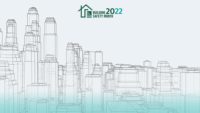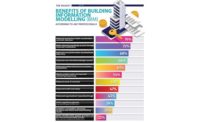According to a recent report by the United Nations, in 2018 from superstorms to fires and floods, more than 62 million people worldwide were impacted by extreme weather.
In the U.S. alone, this rise in extreme weather events is having a devastating effect. Researchers at National Oceanic and Atmospheric Administration (NOAA) estimate the cost of damage in the U.S. over the last five years has been about $500 billion. Now more than ever, it is imperative that buildings and structures are designed and built using the most up-to-date building codes to allow for maximum safety, resilience and sustainability.
Building codes frame the work of architects, plumbers and electricians to name a few, and are what building tradespeople live by. Not only do building codes provide a standard benchmark that contractors must meet, they establish a building’s safety and energy performance for years to come. In recent years, we’ve seen their importance in preserving building resilience and durability in the face of increasingly severe weather events.
In the U.S., the federal government does not standardize building codes for the entire nation. Rather, model building codes are developed by private-sector institutions such as the International Code Council. States and/or local municipalities then adopt these codes with slight modifications that best suit their geographical or constituent needs. The need for a standard method of construction codes across all states was recognized by builders in order to have a level playing field across state and company lines.
In order to meet the concerns expressed by the public and industry regarding code consistency, the ICC developed its first “I-Codes” in 1997. An integrated family of coordinated, modern building safety codes, the I-Codes help ensure the safe, sustainable, affordable and resilient design of building and structures. It is the most widely accepted set of model codes used in the U.S. All 50 states, the District of Columbia, and many other countries have adopted components of the I-Codes at the national, state or jurisdictional level.
Building codes encompass more than what most might think of being the traditional building disciplines — the family of I-Codes includes regulations covering everything from swimming pools and spas to high-rise buildings and best practices for fire-rated construction. But obviously not all states are the same and neither are their needs. California for example, has the risk of severe wildfires, while New York City has more high-rise buildings than any other city in the country.
With updates produced every three years, building codes allow for ongoing consideration of new technologies and scientific understandings, including those that impact flood maps, wind loads and other extreme weather events. For example, I-Codes take into consideration areas that might have specific weather needs, including hurricane clips and bracing to stop wind damage, ice and water shields on roofs to prevent ice damming and water infiltration, flood-resistant construction to help against damaging the foundation of a structure, impact and wind resistant windows/doors, deck attachments and more.
Therefore, the ICC’s I-Codes are developed as ‘model’ codes that can be adopted and modified to best suit the needs of the individual state, region or municipality.
Deeper code dive
Building departments nationwide are given a numerical rating based on several factors, including which edition of the codes a location has adopted and the level that the codes have been modified. The rating is established by the ISO/Verisk (Insurance Services Organization) for the purposes of developing rates for insuring commercial property, based on susceptibility.
ISO/Verisk’s Building Code Effectiveness Grading Schedule (BCEGS) provides insight into a community’s building code enforcement activities as it relates to property losses due to natural and man-made hazards. The BCEGS program looks at a community’s adopted codes, the resources made available for the enforcement of the codes, and the utilization of these resources. Each community receives two classifications: one for commercial properties and one for one- and two-family residential properties, ranging from 1 (exemplary commitment to building code enforcement) to 10. These classifications may be utilized by property and casualty insurers in underwriting and rate development.
Multiple academic studies have shown that BCEGS classifications are a valuable indicator of risk and potential losses in a hazardous event.
While safety is the primary goal, new energy codes are making a major contribution toward solving our energy problems. To date, the International Energy Conservation Code (IECC) has saved U.S. consumers more than $44 billion and avoided 36 million tons of carbon dioxide emissions. Between 2010 and 2040, the U.S. Department of Energy expects that model building energy codes, such as the IECC, will save homeowners and businesses up to $126 billion in energy costs.
The National Model Building codes, produced by the Codes Council, are updated every three years to ensure that the construction design professionals and building trades are implementing the latest technological and safety provisions available.
As climates and high-tech landscapes are evolving and changing, preparing to meet the future challenges of resilience requires buildings to perform more efficiently and be ready to stand up to physical challenges that were unimaginable just a decade ago.



